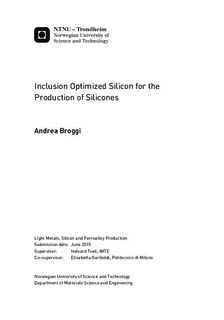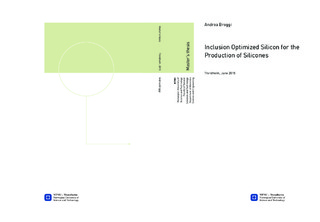| dc.contributor.advisor | Tveit, Halvard | |
| dc.contributor.advisor | Gariboldi, Elisabetta | |
| dc.contributor.author | Broggi, Andrea | |
| dc.date.accessioned | 2016-02-06T15:00:27Z | |
| dc.date.available | 2016-02-06T15:00:27Z | |
| dc.date.created | 2015-06-10 | |
| dc.date.issued | 2015 | |
| dc.identifier | ntnudaim:12620 | |
| dc.identifier.uri | http://hdl.handle.net/11250/2377287 | |
| dc.description.abstract | One of the challenges with silicones production is the accumulation of
impurities from metallurgical grade silicon (MG-Si) in the reactor. Size, shape
and density of the intermetallics affect the accumulation, and their size
distribution is also dependent on the thermal history of silicon. Different
annealing treatments were carried out on MG-Si in order to investigate the reordering
of the intermetallics from liquid state. The surfaces of the sample were
analyzed with BSE-SEM images and the computer program ImageJ®. The
results show that the size of the intermetallics increases with time and
temperature, whereas aspect ratio and inclusions number have the opposite
trend. Temperature above 850°C is a necessary condition for transformations to
start.
The composition was changed after a melting step was performed in air. XRF
chemical analysis confirm the effects of refining and segregation. The software
SiStruc® calculated expected contents of phases based on thermodynamics only.
EPMA and BSE-SEM image analysis estimated the phase composition on a
untreated sample and on a treated one. It can be stated that there could be
reactions between intermetallic phases. The effects of the annealing and
refining on the composition are compared to the expected change on reactivity
and selectivity in the silicones production. | |
| dc.language | eng | |
| dc.publisher | NTNU | |
| dc.subject | Light Metals, Silicon and Ferroalloy Production | |
| dc.title | Inclusion Optimized Silicon for the Production of Silicones | |
| dc.type | Master thesis | |
| dc.source.pagenumber | 153 | |

